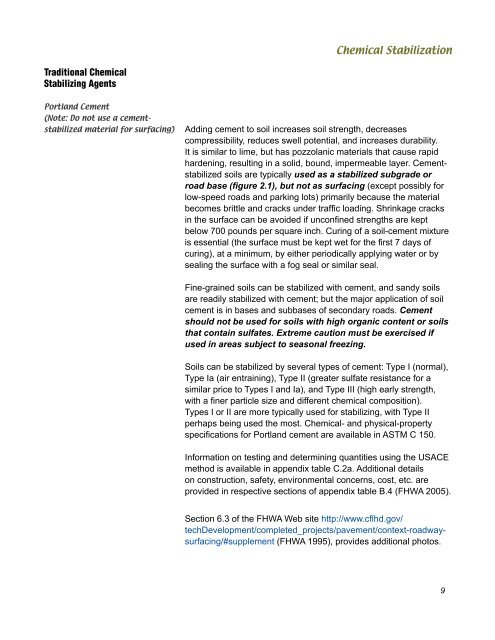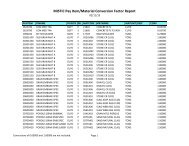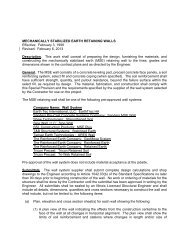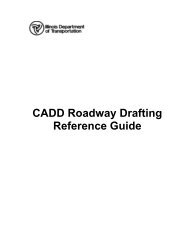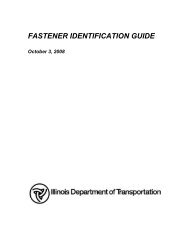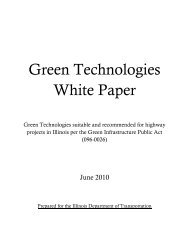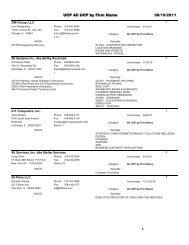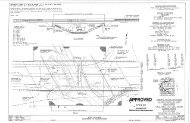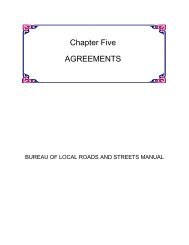Stabilization Selection Guide for Aggregate - Illinois Department of ...
Stabilization Selection Guide for Aggregate - Illinois Department of ...
Stabilization Selection Guide for Aggregate - Illinois Department of ...
You also want an ePaper? Increase the reach of your titles
YUMPU automatically turns print PDFs into web optimized ePapers that Google loves.
Traditional Chemical<br />
Stabilizing Agents<br />
Chemical <strong>Stabilization</strong><br />
Portland Cement<br />
(Note: Do not use a cementstabilized<br />
material <strong>for</strong> surfacing) Adding cement to soil increases soil strength, decreases<br />
compressibility, reduces swell potential, and increases durability.<br />
It is similar to lime, but has pozzolanic materials that cause rapid<br />
hardening, resulting in a solid, bound, impermeable layer. Cementstabilized<br />
soils are typically used as a stabilized subgrade or<br />
road base (figure 2.1), but not as surfacing (except possibly <strong>for</strong><br />
low-speed roads and parking lots) primarily because the material<br />
becomes brittle and cracks under traffic loading. Shrinkage cracks<br />
in the surface can be avoided if unconfined strengths are kept<br />
below 700 pounds per square inch. Curing <strong>of</strong> a soil-cement mixture<br />
is essential (the surface must be kept wet <strong>for</strong> the first 7 days <strong>of</strong><br />
curing), at a minimum, by either periodically applying water or by<br />
sealing the surface with a fog seal or similar seal.<br />
Fine-grained soils can be stabilized with cement, and sandy soils<br />
are readily stabilized with cement; but the major application <strong>of</strong> soil<br />
cement is in bases and subbases <strong>of</strong> secondary roads. Cement<br />
should not be used <strong>for</strong> soils with high organic content or soils<br />
that contain sulfates. Extreme caution must be exercised if<br />
used in areas subject to seasonal freezing.<br />
Soils can be stabilized by several types <strong>of</strong> cement: Type I (normal),<br />
Type Ia (air entraining), Type II (greater sulfate resistance <strong>for</strong> a<br />
similar price to Types I and Ia), and Type III (high early strength,<br />
with a finer particle size and different chemical composition).<br />
Types I or II are more typically used <strong>for</strong> stabilizing, with Type II<br />
perhaps being used the most. Chemical- and physical-property<br />
specifications <strong>for</strong> Portland cement are available in ASTM C 150.<br />
In<strong>for</strong>mation on testing and determining quantities using the USACE<br />
method is available in appendix table C.2a. Additional details<br />
on construction, safety, environmental concerns, cost, etc. are<br />
provided in respective sections <strong>of</strong> appendix table B.4 (FHWA 2005).<br />
Section 6.3 <strong>of</strong> the FHWA Web site http://www.cflhd.gov/<br />
techDevelopment/completed_projects/pavement/context-roadwaysurfacing/#supplement<br />
(FHWA 1995), provides additional photos.<br />
9


